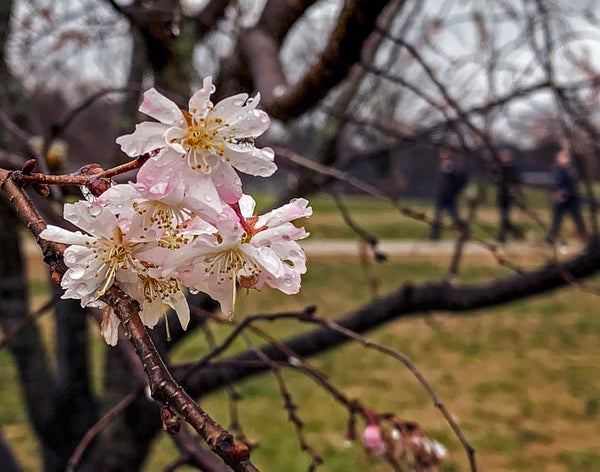Climate change is messing with Washington’s cherry trees by forcing the plant’s pink-and-white blooms to pop earlier in the year.
The new pattern, and the unpredictability it could bring, has caught the attention of scientists, but local shopkeepers should take note, too—as the change could affect when tourists come to see the fluffy blooms.
“Long-term trends in both Washington D.C. and Japan reveal that cherry blossoms are emerging at increasingly earlier times,” Mike Litterst, a spokesman for the National Park Service, said in a statement to E&E News.
On supporting science journalism
If you're enjoying this article, consider supporting our award-winning journalism by subscribing. By purchasing a subscription you are helping to ensure the future of impactful stories about the discoveries and ideas shaping our world today.
Park service records show that temperatures at the Tidal Basin, where the Washington blooms are most prolific, have risen steadily at a rate of 1.1 degrees Celsius per century, from 1895 to 2017.
“These observations are consistent with the effects of rising temperatures, as the onset of warm temperatures are a known catalyst for the blossoms,” Litterst noted.
The park service predicted this week that peak bloom this year likely would occur between March 27 and March 30—which is about five days earlier than the average bloom dates of the last century.
The blooms follow on the heels of the world’s warmest January in more than a century, according to a recent report by NOAA.
And, according to the USA National Phenology Network, spring “leaf out”—the appearance of tiny leaves that signal the start of spring—arrived 24 days early for places like Washington.
Theresa Crimmins, director of the USA National Phenology Network and a research scientist at the University of Arizona, said there is “ample documentation” of warmer winters and springs generally, which means early blooming for many flowering plants.
She said it’s unclear how climate change would play out long term for the cherry blossoms, but changing warmth patterns are almost certain to affect the timing of their flowering.
That could affect decades of tradition in Washington.
Three thousand cherry trees were gifted to the nation’s capital in 1912 by Tokyo Mayor Yukio Ozaki as a symbol of friendship between the United States and Japan. The first saplings were planted along the Tidal Basin, and since then, they’ve become an enduring symbol of the district.
According to the park service, the National Cherry Blossom Festival attracts about 1.5 million visitors to Washington annually—which adds up to about $150 million to the area.
But research shows variable temperatures in the Mid-Atlantic could make the annual pilgrimage to the Tidal Basin harder to plan. Authors based in Seattle and Seoul, South Korea, found in 2011 that peak bloom dates for Washington’s cherry trees are “likely to be accelerated by an average of five days by 2050 and 10 days by 2080.”
Phenology experts—those who study the seasonal patterns of plants and animals—have tracked fluctuations in flowering plants, and the animals affected by them, for years due to climate change.
Japan’s own sakura blossoms also have fallen on hard times with the unpredictability of the seasons. Researchers in 2009 found, after examining blooming patterns from festivals dating back to the ninth century, that Kyoto cherries are blooming earlier than they have been in the last 1,200 years.
Climate change is affecting other blooms, too.
The Augusta National Golf Club—host to the Masters championship golf tournament—has had trouble with the variability of the blooms of its azalea flowers. An early spring in 2017 for parts of the southeast U.S. left horticulturalists worried that the colorful azaleas would pop too early to be at peak performance for the contest.
Another concern is that a too-early bloom could be ravaged by a return of cold weather. Early blooming before subsequent frosts can cause severe economic impacts for producers relying on flowering crops.
Baby leaves are hardier than flower buds, Crimmins said. They can bounce back from an early frost and reproduce. “But if the tree has already put all this energy into producing flowers and those flower buds or flowers get hit by frost, usually they don’t reinitiate flower production,” she noted. That means there’s no fruit.
But Crimmins also noted that some plants—like cherry blossoms—rely on a good chill to fully bloom during higher temperatures that follow. So without that chill, some plants actually could start blooming even later than usual depending on how the seasons fluctuate.
“So it’s really kind of a toss-up truthfully as to what might happen in the future, whether if because of increased warmth they’ll advance, or because of insufficient chill they’ll be delayed,” Crimmins said of the blossoms.
New weather patterns are “exposing these poor plants to conditions that they’re just not used to, and we don’t really know what might happen,” she added.
Reprinted from Climatewire with permission from E&E News. E&E provides daily coverage of essential energy and environmental news at www.eenews.net.
